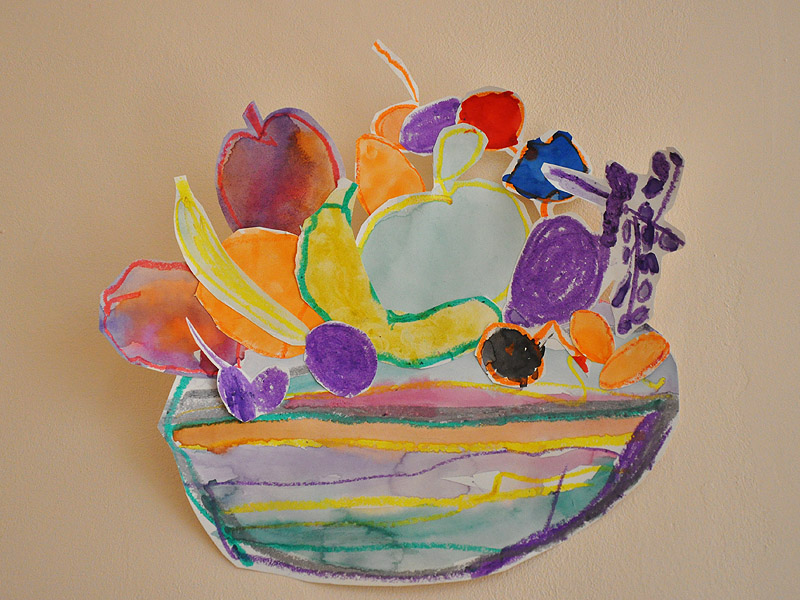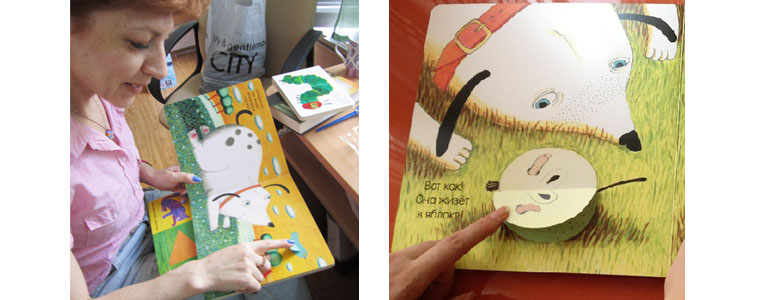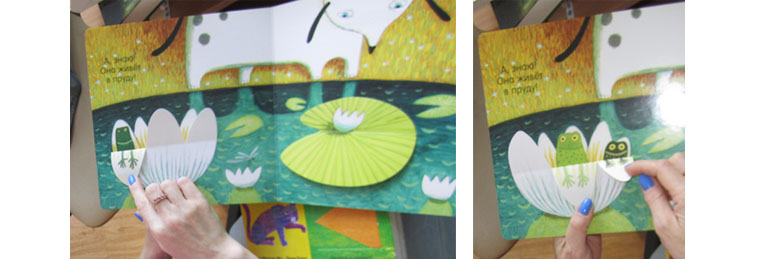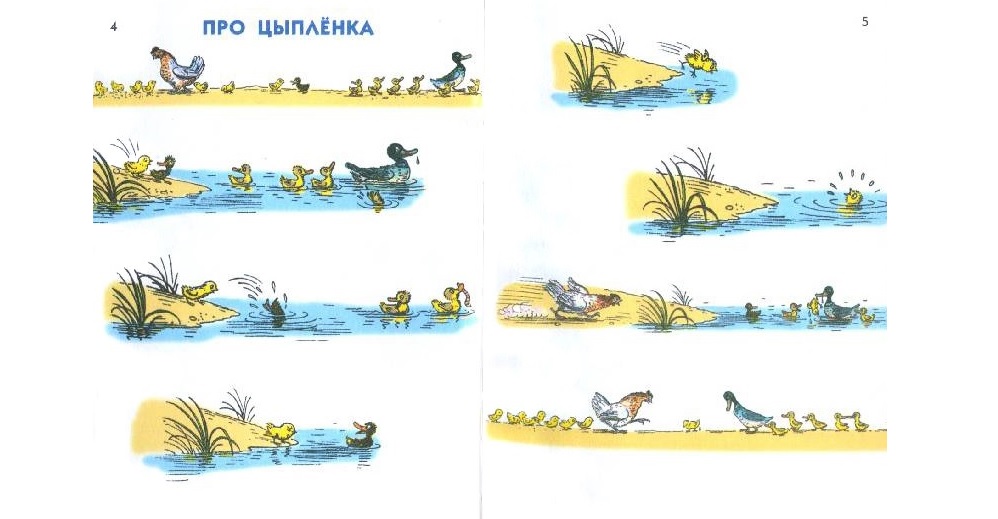
Bibliotherapy is not quite an actual term. It’s more of a metaphor—books heal people. A book can heal just like a painting or actual landscape or potted flower on the windowsill can. Like anything a person turns to for comfort in a time of emotional distress. But at the inclusive Our House Our House is a municipal preschool in Moscow, Russia that has existed since 1992 and where children with special needs have access to a wide range of of aided education programs. preschool, books truly help children overcome various difficult issues.
For the 2014-2015 school year, several publishers donated books to Our Home, to be read aloud to the children or used in remedial work. Speech therapist Oksana Chistyakova told us how these books “work” to help children. Her experience may be useful for any adult that reads to children and reinforces our understanding that reading is a highly individualized process and is only important as such.
Very different children attend our center. People are often surprised to learn we even have a waiting list for children without developmental delays. Clearly, something in the way we work with children, in the way the preschool is run, attracts parents here.
Naturally, for children with developmental issues, we have both group and individual activities. These activities are conducted by psychologists and defectologists. The activities nearly always include contact with books. For some children, this poses a real challenge. They may have limited or negative experience interacting with books. One such case was O, a four-year-old boy that comes to my sessions and practically doesn’t speak. He doesn’t have a particular speech problem—rather, his is an issue of communication. Of course, the result of his underdeveloped ability to communicate is delayed intellectual development. When his mom first brought O in, she warned me. “I just wanted to let you know: don’t show him books. He doesn’t understand them. He gets very agitated when someone offers to read to him. Even seeing a book can provoke an aggressive response.”
I understand why the child has such a reaction. Parents aren’t always willing to accept that they will have to raise a special child. They block out those thoughts and try to behave like everyone else. They know reading is good, so they try to get a child into it, whether he wants to or not. They read what he doesn’t understand. The entire activity—reading—in the form his mom presents it, is too much.
So of course he resists. He has it hard enough already. Meanwhile, his mom draws a mistaken “conclusion”: “He doesn’t like when he’s read to!” Could it be that he doesn’t like it? Sure. Sometimes it takes time to find an explanation for this aversion.
As for me, I know that books are absolutely indispensable for kids. It’s up to us to come up with ways to make encounters with books necessary, rather than repellent, for a “problem” child.
Brown Bear, Brown Bear, What Do You See? Most recent English edition: Puffin, 2018. ISBN 9780241330340 by Eric Carle
Eric Carle’s Brown Bear, Brown Bear, What Do You See? was the first book I decided to show O. It was very important not to frighten the boy.
I said: I’m going to show you something now. But don’t worry: we won’t read. We’ll just see what it is. And he agreed: alright, let’s look—as long as we don’t read.
And I didn’t read. I showed him the bear: see the little bear? And who do you see there? Do you want to open the window? Open it, if you want.
Of course, O wanted to open the window. It was an invitation to action, after all. No child could resist an invitation like that. So we looked together: in the little window was a picture of a bird. We turned the page and there was the same bird, just bigger. We weren’t fooled! The child feels that satisfaction when he sees the page: he’d guessed that there would be a bird there. And there it was.
We leafed through the whole book. But were we reading? I asked questions and he reacted as best he could. He turned pages. I kept my word as far as he was concerned, but I also fulfilled my own mission—we had our first book under our belts.
Brown Bear quite quickly became vital for O. Despite its apparent simplicity and dearth of text, this little book carried some serious learning material. There were the names of the animals. O quickly learned them and even started answering me. I would ask, as though to myself: who do we see? And he knew and would say: duck. For an autistic child, the most difficult thing is to enter into a dialogue. Now when I was asking who was up ahead and he was answering: duck, we were already making a small step toward dialogue. Question—answer—it’s the structure of dialogue. This was major progress in socialization.
I say (as though to myself again)...there’s a yellow duck here. It’s not quite clear if O understands colors. But he hears me and repeats the phrase. After some time, he doesn’t answer my question with just “duck,” but says “yellow duck.”
Where Does the Bird Live? Russian edition: Clever Media Group, 2014. ISBN 9785919823476 by Lena Tsvetaeva
Our repertoire began expanding bit by bit. The book Where Does the Bird Live? made its appearance.
This book is also interactive and has elements you can feel with your fingers. Many children with developmental delays find it very challenging to work with their eyes only, or ears and eyes, since it’s hard to combine visual and auditory impressions. When fingers come into play, they help the eyes encounter the picture.
In Where Does the Bird Live?, the child looks for the bird. Not all “our” children know that birds live in special places, in nests. It’s not easy to find a nest in the city—even birdhouses are a rare sight. So all this is entirely new information for the child. This book, like Brown Bear, allows us to draw the child into a dialogue.
I ask: where does the little bird live? In an apple? The child says no. But first there’s a necessary step—lift up the cardboard flap and check. Sure enough, there’s no bird in the apple. There’s a worm in there.

Of course, the child doesn’t begin to answer right away. At first I ask and answer. Meanwhile, he works with his hands, feeling the book with his fingers. When he starts to answer, he doesn’t yet use his own words, he simply repeats what he’s heard. Still, it’s a dialogue in its structure—answers follow questions.
With Lena Tsvetaeva’s book, we allow ourselves more freedom. We diverge from the text, play out different elements, add some difficulty to our “search.” For example, the book has an illustration with three frogs. They’re all “hiding” behind the water lilies. And they’re all different, which is great. Each time I turn over one of the flaps the boy doesn't know which frog will appear behind it. He also points out different animals and says a few words. He even says, “Good night, little bird” now.

This is approximately how a very young child acts, one that doesn’t speak yet. Children with developmental delays often behave as typical children do at an earlier developmental stage. It’s very important, however, to note and record this behavior (here’s what he can do). We have a point of departure. Here are abilities and knowledge that form a base for new information. It’s slow but it will come with systematic work that takes into account the abilities of each individual child.
The Very Hungry Caterpillar Most recent English edition: Puffin, 2016. ISBN 9780141385778 by Eric Carle
We started out with one book. Then, our collection grew. Now I can lay several books out in front of O and ask which we’ll look through today.
Of course, Eric Carle’s The Very Hungry Caterpillar is in that group. This book is a favorite with almost all of our kids. It’s a pleasure to explore both visually and with the touch. After all, it shows things you can eat. Children love to discuss the foods they like best. And it’s so nice to talk about strawberries in the middle of winter!
Besides, those little holes are perfect for little fingers. There hasn’t been a child yet that hasn’t poked at the little holes in this book. Of course, not all of them dare to do so the first time—sometimes, it’s the third. For the children that speak, we read the book as its written. For those that have difficulty speaking, we replace some words, reading “lollipop” as “candy,” “a slice of Swiss cheese” as “cheese.” And so on: “meat,” “cucumber” to keep things simple. If we read the book with “normal” kids, it’s a feast of a dialogue. The book begs the questions: what flavor was the ice cream the caterpillar ate? If it’s orange, could it be orange-flavored? And so on.

Each time we reach the end, it’s a little surprise for the kids, even for children without developmental delays, who know or suspect that the caterpillar will become a butterfly. But when you open that last page, there’s always a gasp—it’s so beautiful! First there was this little worm, not particularly good-looking. And suddenly we have this transformation. The butterfly’s body is tiny but it’s the wings that matter. They take up all the space on the pages and shine with all the colors of the rainbow. And look at the eyes on that butterfly!
The children love all that. This book “works” for kids of any age, especially at speech therapy sessions.
These three books I’ve mentioned —Brown Bear, Where Does the Bird Live? and The Very Hungry Caterpillar are universal and almost always a success with children. They can be read with any children, even those with particularly difficult issues.
The Tiger Who Came To Tea Most recent English edition: HarperCollins, 2018. ISBN 9780007215997 by Judith Kerr
Judith Kerr’s books are more complex—both in their illustrations and content. But I had a girl with speaking issues that latched on to The Tiger Who Came to Tea specifically. She was entranced by the list of foods the Tiger ate. She and I would list it all: what he ate, and what Sophie and her mom then went to buy. We played with toy food items, played “store,” and “set the table” for the Tiger.
This success with Judith Kerr’s book, however, is a particular case with this particular girl.
Hairy Maclary from Donaldson’s Dairy Recent English edition: Puffin, 2013. ISBN 9780723278054 by Lynley Dodd
There was a similar story with Hairy Maclary. Among the children I work with is D, a girl with underdeveloped speech. Her typical behavior involves an aversion to any exertion. When it’s hard for her to say something, she prefers to remain quiet. I think it’s a sort of life strategy she’s developed—avoid difficulties, don’t try to overcome them, just drift. If she’s having trouble with something, doesn’t have enough information, or there’s a situation where she needs to ask a question, she won’t. If it doesn’t work out, that’s fine with her.
Speech correction, however, requires work. First and foremost, of course—speaking aloud. No matter what, she should speak as much as possible. So we have to incite answers with questions and encourage exertion in speech.
Lynley Dodd’s book was a lifesaver for D. Its images and rhymes are impossible to turn away from. Once you’ve said one of the dog’s names—“Hercules Morse“, the next line—“as big as a horse” is just begging to be said as well. Or “Bitzer Maloney—“all skinny and bony.” And so on.

As you pronounce the words and catch the rhymes, you should also understand what you’re saying. So what is “Shnitzel Von Krumm with a very low tum” like? What does he look like? Can you describe him? Draw him? And D, amazingly, tried with all her might to imagine it and even express it. But first she had to utter an important phrase: “I don’t understand!” That was her response when I asked her if she understood what the dog in the description was like. She said, “I don’t understand”—and so made a spoken admission that was essentially a question. Our work together was off to a strong start.
Different books
The above books were a discovery for me as well—a sort of celebration.
I’m a specialist with years of experience, including education in the Soviet system. At the time, the main books we used in our work were those of Vladimir Suteev and Nikolay Radlov. These were considered speech therapy classics—stories in pictures. They were always there and there was nothing besides them. We still use them, of course. There are children that really like these books, especially those that enjoy “reading,” imitating the process of reading, as our children with Down syndrome do. It is particularly gratifying when an adult is present and they can complete sentences. The adult starts off with “Once upon a time, there were…,” and the child says: “Ducklings.”

Story in pictures by Vladimir Suteev
Still, for the majority of our children, classic stories in pictures are a bit too complex. Books with multiple characters are not very suitable for them in general. Those are appropriate for “normal” children at a very particular phase of development. So these Soviet classics are certainly still in use, but we’re very happy that something new has come along.
After all, speech therapists and defectologists are people too. We adults need something new as well—new books with new opportunities. A new book often suggests a new approach in our work. Each child represents a very particular set of issues that requires us to come up with a new set of “keys” each time.
From this perspective, we find it very important that Eric Carle’s books are printed on thick paperboard. We don’t worry that they’ll tear after several children see them. We aren’t afraid to give them to kids to touch, leaf through, and play with. In Where Does the Bird Live? the interactive flaps are made from thin paperboard and are more fragile. Here we have to be careful. There are some children I don’t offer the book to, knowing that they will want to pull hard or tear something out. I try to make sure that children that do need the book know to be gentle.
The more new books we have, the more opportunities open up in our work, and the more opportunities our kids have to develop and grow.
As told to Marina Aromshtam
Translated from the Russian by Alisa Cherkasova
This article was originally published in 2015
Follow us on Facebook.
